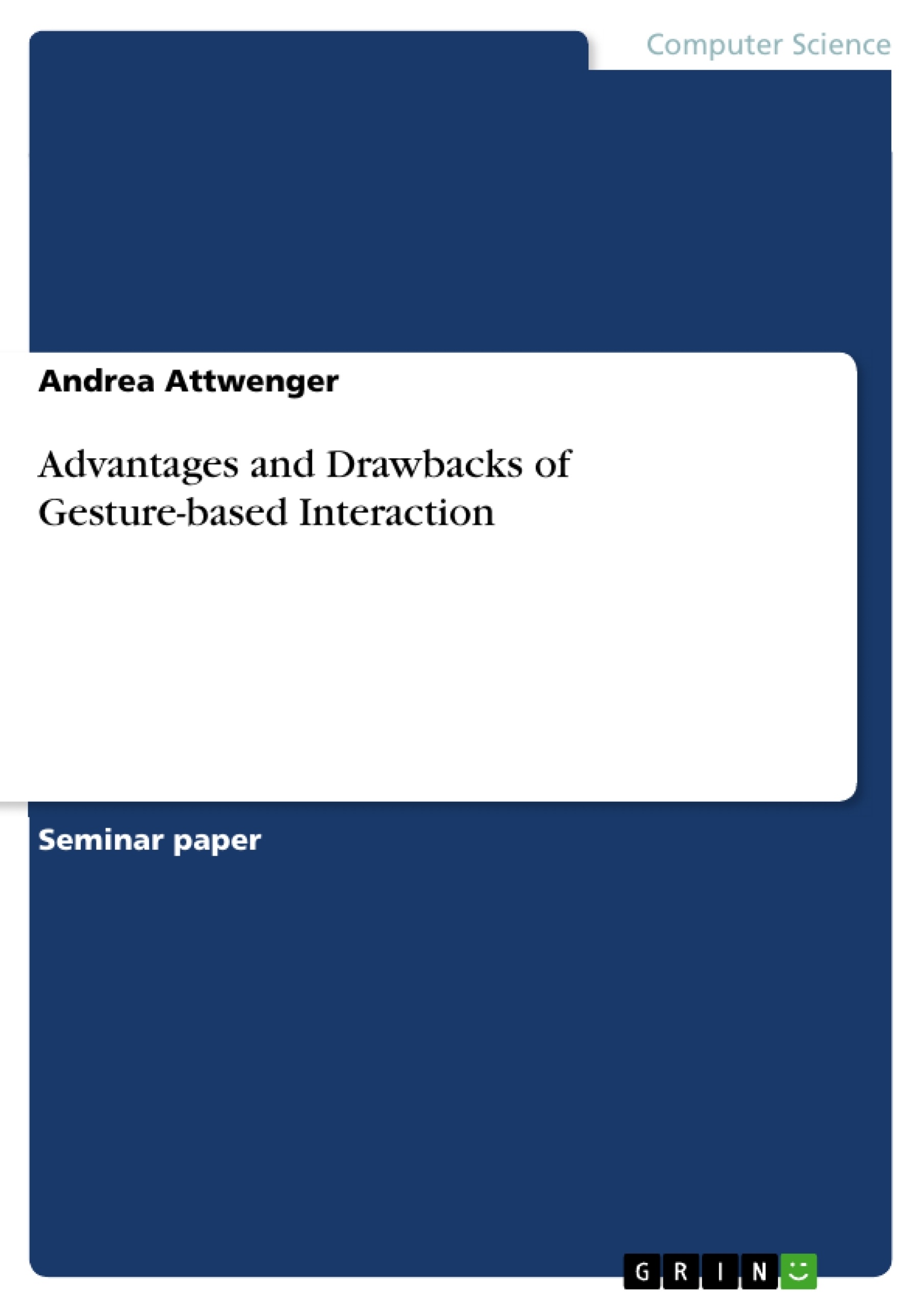With the increasing prevalence of smartphones, gesture-based interaction has arrived in our everyday life, but we still do not exploit its full potential. This paper describes the benefits and drawbacks of gestural input and presents interaction techniques that address these drawbacks.
Gestures provide the user with a new form of interaction that mirrors their experience in the real world. They feel natural and require neither interruption nor an additional device. Furthermore, they do not limit the user to a single point of input, but instead offer various forms of interaction.
However, gestures also raise issues that are not relevant with traditional methods of input. The need to be learned and remembered, which requires the development of guides that promote the discoverability and memorability of these gestures and deal with input and recognition errors. Another aspect is the design of the gestures itself, which should make them memorable and easy and comfortable to execute.
Inhaltsverzeichnis (Table of Contents)
- 1. Introduction
- 2. Advantages
- 2.1 Immediate and powerful interaction
- 2.2 Intuitiveness and enjoyability
- 3. Drawbacks and possible solutions
- 3.1 Discoverability
- 3.2 Memorability
- 3.3 Fatigue
- 3.4 Recognition Errors
- 3.4.1 Immersion
- 3.4.2 Exit errors
- 4. Conclusion
Zielsetzung und Themenschwerpunkte (Objectives and Key Themes)
This paper aims to explore the advantages and disadvantages of gesture-based interaction, particularly in the context of increasing smartphone usage. It investigates how gesture-based input mirrors real-world experiences and offers alternative interaction methods beyond traditional input devices. Furthermore, it examines challenges related to gesture design, learnability, and error handling.
- Advantages of gesture-based interaction compared to traditional input methods.
- Challenges in the design and implementation of intuitive and efficient gestures.
- Strategies to improve the learnability and memorability of gestures.
- Methods for mitigating recognition errors and user fatigue in gesture-based systems.
- Exploration of various interaction techniques that address the drawbacks of gesture-based input.
Zusammenfassung der Kapitel (Chapter Summaries)
1. Introduction: This chapter introduces the increasing prevalence of gesture-based interaction, particularly with the rise of smartphones, and sets the stage for exploring the advantages and drawbacks of this interaction method. It highlights the naturalness of gesture interaction as it mirrors real-world communication, contrasting it with the limitations of traditional desktop computing paradigms.
2. Advantages: This chapter delves into the benefits of gesture-based interaction. It emphasizes the immediate and powerful nature of gestures, eliminating the need for interruptions and additional devices. The inherent intuitiveness and enjoyment associated with gestures are also highlighted, referencing studies that demonstrate improved user experience and performance compared to traditional input methods. Examples are given to show how gestures allow for multiple points of input and the definition of several parameters simultaneously.
3. Drawbacks and possible solutions: This section addresses the challenges posed by gesture-based interfaces. It identifies issues such as discoverability, memorability, fatigue, and recognition errors. It then proposes and discusses various solutions designed to alleviate these drawbacks. The chapter covers systems like OctoPocus, ShadowGuides, and GestureBar, detailing their mechanisms for enhancing discoverability and providing feedback to the user.
Schlüsselwörter (Keywords)
gesture, gesture design, learnability, memorability, gesture recognition, user interface, human-computer interaction, discoverability, error handling, fatigue, multi-touch, mid-air gestures.
Frequently Asked Questions: A Comprehensive Language Preview of Gesture-Based Interaction
What is the main topic of this document?
This document provides a comprehensive overview of gesture-based interaction, examining its advantages and disadvantages, particularly within the context of increasing smartphone usage. It explores design challenges, learnability, error handling, and offers solutions to improve user experience.
What are the key advantages of gesture-based interaction discussed?
The document highlights two primary advantages: the immediate and powerful nature of gestures, allowing for quick and efficient interaction without extra devices or steps; and the intuitiveness and enjoyment they offer, leading to improved user experience and performance compared to traditional input methods. The ability to input multiple points and parameters simultaneously is also emphasized.
What are the main drawbacks of gesture-based interaction?
The document identifies several key drawbacks: discoverability (users understanding available gestures), memorability (users remembering gestures), fatigue (physical and mental strain from use), and recognition errors (the system misinterpreting gestures). Specific challenges include immersion and exit errors.
What solutions are proposed to address the drawbacks of gesture-based interaction?
The document explores various solutions to improve gesture-based interfaces. It mentions systems like OctoPocus, ShadowGuides, and GestureBar as examples of technologies designed to enhance discoverability and provide better user feedback, mitigating issues like recognition errors and user fatigue.
What are the key themes explored in this document?
The key themes include: comparing gesture-based interaction to traditional input methods; the challenges in designing intuitive and efficient gestures; strategies for improving gesture learnability and memorability; methods for reducing recognition errors and user fatigue; and exploring various interaction techniques to overcome limitations of gesture-based input.
What are the chapter summaries?
The document includes summaries of its four chapters: Chapter 1 introduces gesture-based interaction and its growing prevalence; Chapter 2 focuses on the benefits of this interaction style; Chapter 3 delves into the challenges and potential solutions; and Chapter 4 offers a conclusion.
What keywords are associated with this document?
The keywords include: gesture, gesture design, learnability, memorability, gesture recognition, user interface, human-computer interaction, discoverability, error handling, fatigue, multi-touch, and mid-air gestures.
What is the overall objective of this document?
The document aims to provide a balanced exploration of the advantages and disadvantages of gesture-based interaction, offering insights into its design, implementation, and potential for improvement in user experience. It aims to contribute to a better understanding of this interaction modality.
- Quote paper
- Andrea Attwenger (Author), 2014, Advantages and Drawbacks of Gesture-based Interaction, Munich, GRIN Verlag, https://www.grin.com/document/369514




